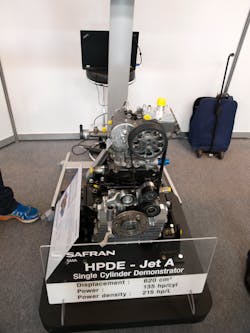During the last AERO 2016 aviation expo in Germany, the SMA debuted a diesel-cycle, engine demonstrator with unprecedented, hard to believe, high power density, which could be able to compete with turboprop powerplants in the 400- to 800-hp power range. Is this – finally – a breakthrough in the diesel, piston engine field? A new hope for the GA? AMT European Correspondent Marino Boric inquired and collected the following information.
According to the French SMA (100 percent subsidiary of Safran Aircraft Engines) the research demonstrator HPD, a four-stroke, diesel cycle, one-cylinder engine, with only 38-cubic-inch (0.62 liter) displacement develops 135 hp (100 kw). This data are according to SMA not theoretical assumptions but practical (dyno) measurements. This is the equivalent of 215 hp (160 kw) per liter displacement with a specific fuel consumption of 0.35 lb./hp/hr. (210 g/kwh) and thus according to SMA it is a world champion in this field. Making a projection, this will mean that an 800-hp, 3.7-liter displacement engine could weigh only 533 pounds (240 kg) and feature an almost incredible 1.5 hp/lb. (2.5 kw/kg) power density.
A World Class Piston Engine in Power Density
According to SMA this high power density engine (HPDE) equals the small turbines by weight, yet retains the low fuel consumption of compression ignition piston engines slashing the turbine consumption at least by half.
This design apparently surpasses all other available powerplant options allowing aircraft to significantly increase payload, range, and endurance, while operating on jet or bio fuels, reducing CO2 emissions and noise. As a comparison, this design exceeds best-known diesel engines like the Le Mans 24h car endurance racing LMP1 engines by 15 percent in power density and by 30 percent in specific power, yet matches a typical aircraft engine service life.
How Does It Work?
SMA is not (yet) willing to unveil the secrets of the HPDE engine as many technologies are right now being patented but the key seems to be in the much different, on purpose, designed engine. SMA says that the key is to design the engine from the ground up only for aeronautical application, and for only one optimized design point. Automotive applications have to be optimized for several design points that lead to (too) many compromises.
The HPDE concept is optimized for engines in the power range from 400 to 800 horsepower (hp). According to SMA, below 400 hp the concept is limited by the packaging, and above 800 hp the weight penalty becomes too high to compete with gas turbines.
SMA's benefited from SAFRAN’s know-how and used a mix of patented parts and off-the-shelf components from the automotive industry which enabled SMA to break new frontiers.
Genesis of the Engine
The SMA goal was to design a high power density, jet-fuel burning engine in the power density range of turbines, but with the low fuel burn of compression ignition engines (CIE).
Turbines are well known for their high power-to-weight ratios, but in the low power range their fuel burn is between two and three times higher than the compression ignition engines fuel burn.
Turbine wheels are optimized for high power settings that lead to a loss of efficiency in partial load operation in cruise flight. Compression ignition engines maintain a relatively constant specific fuel consumption throughout their power range.
SMA investigated which design could offer an opportunity to implement a piston engine instead of a turbine with similar packaging, the same power output but with half the fuel consumption. One of the main challenges was to guarantee a durability equivalent to a gas turbine with the same reliability level. The SMA goal was to design a piston engine burning Jet-A fuel, with the power density of a Formula 1 race-car engine, but with a truck engine durability. To achieve this challenging goal, SMA figured out that this is doable only by a brand new concept and not by a conversion of an automotive powerplant.
The SMA Concept
After a deep benchmarking, the SMA task-force identified different pathways to reach the goal; many possibilities were considered, from immature but very promising technology like liquid piston engines and combinations of new and classic automotive solutions. Engine concepts used in racing applications were a good compromise to reach the power density in a fair timescale. They are able to deliver the predicted power, but they lacked durability and cost efficiency. SMA found the best compromise for desired range of power in a “classical” four-stroke engine in which piston geometry, injector performance, turbo efficiency, and lightweight technologies were selected.
In 2014, the team designed the combustion chamber and established the parameters to confirm the potential. A single-cylinder device was created to explore the full capability of the concept. The optimal configuration solution remained open - an in-line or boxer arrangement is possible - and depends on the final customer requirements.
2015th Milestone
The first step was achieved in late 2015 with the combustion chamber design validation, including piston and cylinder shapes, air inlet/outlet, injection, etc. developed in partnership with the Clean Sky European program. The project presentation occurred in April 2016.
Possible Applications
For the final multi-cylinder (to be developed) engine a full range of applications has been considered: from a propulsive engine mechanically driving a propeller to a range extender, including hybrid architectures generating electrical power for use in general aviation and unmanned aerial vehicles (UAV).
The most beneficial use of the HPDE engine is for long distance and endurance missions. UAVs are the most promising applications as this new engine can double the mission range or endurance.
The HPDE concept can be developed for in-line or horizontally opposed configurations depending on the room available on the target aircraft. The best compromise can be achieved with a six-cylinder engine weighing (installed) about 530 pounds (240 kg). The SMA multi-cylinder engine could be used as a light-weight and efficient jet-A power generator, or as a range extender with 1.5 hp/lb. (2.5 kw/kg).
About the Author

Marino Boric
Marino Boric graduated with a university degree as an aeronautic engineer, and acquired degrees in business development/trade and commerce and in journalism. He is a civil and military pilot and has built experimental aircraft. As a journalist, he specializes in aviation and propulsion and travels worldwide, flight-testing UL, LSA, Experimental, and certified aircraft. He is writing for U.S., European, and Chinese media companies.
